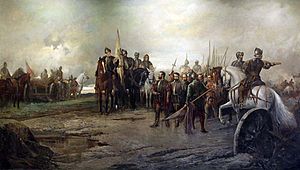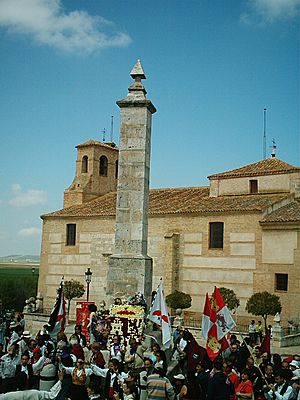Battle of Villalar facts for kids
Quick facts for kids Battle of Villalar |
|||||||
|---|---|---|---|---|---|---|---|
| Part of the Revolt of the Comuneros | |||||||
 A 19th century work by Manuel Picolo López depicting the Battle of Villalar. |
|||||||
|
|||||||
| Belligerents | |||||||
| Royalist Castilians | Comuneros | ||||||
| Commanders and leaders | |||||||
| Íñigo Fernández | Juan López de Padilla (POW) Francisco Maldonado (POW) Juan Bravo (POW) |
||||||
| Strength | |||||||
|
8,400 men
|
7,400 men
|
||||||
| Casualties and losses | |||||||
| 20–30 dead | 500–1000 dead | ||||||
The Battle of Villalar was a very important fight in the Revolt of the Comuneros. This rebellion happened in Spain a long time ago. The battle took place on April 23, 1521, near a town called Villalar.
In this battle, the soldiers who supported King Charles I won a huge victory. They defeated the rebels, known as the Comuneros. Three of the main rebel leaders, Juan de Padilla, Juan Bravo, and Francisco Maldonado, were caught. They were executed the very next day. This defeat pretty much ended the rebellion against King Charles I.
Contents
What Happened Before the Battle?
Armies on the Move in 1521
In March 1521, the king's army (called the royalists) decided to join their forces. Their goal was to attack Torrelobatón, a place held by the rebels. The Constable of Castile, a top royalist leader, moved his troops from Burgos. He planned to meet another royalist leader, the Admiral, near Tordesillas.
This move was possible because a rebel force, led by the Count of Salvatierra, was busy fighting elsewhere. The Constable's army had about 3,000 foot soldiers and 600 horse soldiers. They also had several cannons and other artillery.
Meanwhile, the Comuneros rebels tried to make Torrelobatón stronger. But their soldiers were leaving, and the castle wasn't very safe. The royalists had powerful artillery, which made the castle even more vulnerable.
The rebel commander, Juan de Padilla, thought about moving his army to Toro. He hoped to get more soldiers there. But he waited too long to make a decision. This delay allowed the royalist armies to join together in Peñaflor.
The Battle Begins
The royalist army chased the Comuneros. The royalists had a big advantage in horse soldiers, also known as cavalry. They had 2,400 cavalry compared to Padilla's 400. The royalist army also had 6,000 foot soldiers, while Padilla had 7,000.
Heavy rain made it hard for Padilla's foot soldiers to move quickly. The rain also made the rebels' early firearms almost useless. Padilla wanted to reach the safety of Toro, but his foot soldiers were too slow. So, the battle began at the town of Villalar.
The Comuneros tried to use their artillery to stop the royalist cavalry charge. But their cannons didn't work well. Some reports even say the rebel artillery caused more harm to their own side than to the royalists.
There are different ideas about why this happened. Some say the Comuneros were betrayed. They believe their artillery and some soldiers were paid by the royalists to switch sides. These soldiers supposedly fired their cannons too high on purpose. Other theories suggest the rain simply made the artillery useless. It's also possible the artillerymen just panicked during the fight.

The royalist cavalry charges broke through the rebel lines. This quickly ended the battle and turned it into a terrible defeat for the Comuneros. Around 500 to 1,000 rebel soldiers were killed. Many others simply ran away.
The three most important rebel leaders were captured: Juan de Padilla, Juan Bravo, and Francisco Maldonado. They were beheaded the next morning in Villalar's town square. Many royalist nobles watched. The remaining rebel soldiers scattered. Some tried to join another rebel army, while others fled to Portugal. This battle was a huge blow to the rebellion.
What Happened After the Battle?
After losing their leaders and their army, the rebel cities in Old Castile soon gave up. The Constable's armies then marched south to New Castile and took back Madrid. They probably would have taken Toledo too.
However, France invaded Navarre, a region controlled by Spain. So, the royalist army had to quickly go north to fight the French. Because of this, the Revolt of the Comuneros lasted a few more months. Toledo, for example, kept fighting until October.
Why is This Battle Still Remembered?
The Battle of Villalar became a symbol for Spanish liberals much later. They saw it as the moment when the freedom of Castile was lost. They believed it led to a very powerful Spanish monarchy. This idea started in the 1820s.
A military leader named Juan Martín Díez even searched for the remains of the three rebel leaders executed in 1521. Later, in the 1920s, some cities called for celebrations at Villalar.
After the end of Franco's dictatorship in Spain, this view became even more popular. The region of Castile and León made April 23 their official holiday in 1986. It had been celebrated by people since 1976. This day is celebrated every year in Villalar. The town even changed its name to Villalar de los Comuneros to honor the rebels.
See also
 In Spanish: Batalla de Villalar para niños
In Spanish: Batalla de Villalar para niños


